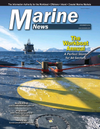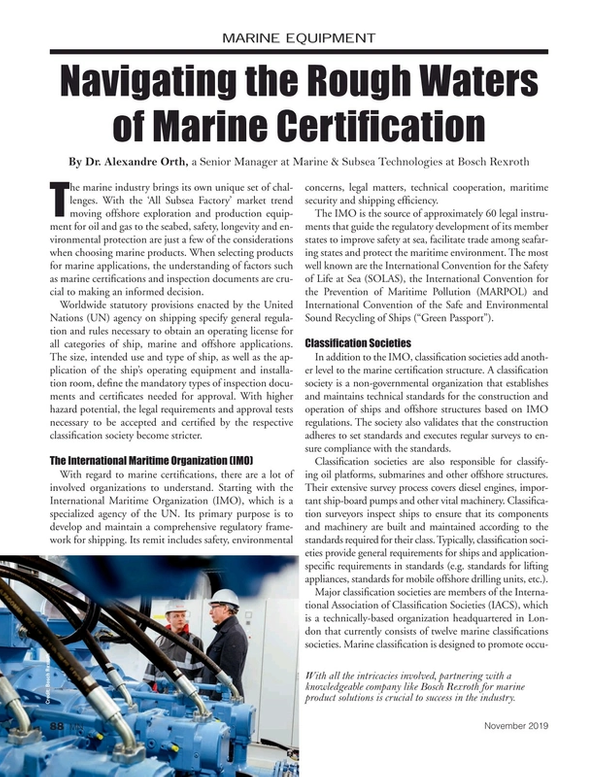
Navigating the Rough Waters of Marine Certification
The marine industry brings its own unique set of challenges.
With the ‘All Subsea Factory’ market trend moving offshore exploration and production equipment for oil and gas to the seabed, safety, longevity and environmental protection are just a few of the considerations when choosing marine products. When selecting products for marine applications, the understanding of factors such as marine certifications and inspection documents are crucial to making an informed decision.
Worldwide statutory provisions enacted by the United Nations (UN) agency on shipping specify general regulation and rules necessary to obtain an operating license for all categories of ship, marine and offshore applications. The size, intended use and type of ship, as well as the application of the ship’s operating equipment and installation room, define the mandatory types of inspection documents and certificates needed for approval. With higher hazard potential, the legal requirements and approval tests necessary to be accepted and certified by the respective classification society become stricter.
The International Maritime Organization (IMO)
With regard to marine certifications, there are a lot of involved organizations to understand. Starting with the International Maritime Organization (IMO), which is a specialized agency of the UN. Its primary purpose is to develop and maintain a comprehensive regulatory framework for shipping. Its remit includes safety, environmental concerns, legal matters, technical cooperation, maritime security and shipping efficiency.
The IMO is the source of approximately 60 legal instruments that guide the regulatory development of its member states to improve safety at sea, facilitate trade among seafaring states and protect the maritime environment. The most well known are the International Convention for the Safety of Life at Sea (SOLAS), the International Convention for the Prevention of Maritime Pollution (MARPOL) and International Convention of the Safe and Environmental Sound Recycling of Ships (“Green Passport”).
Classification Societies
In addition to the IMO, classification societies add another level to the marine certification structure. A classification society is a non-governmental organization that establishes and maintains technical standards for the construction and operation of ships and offshore structures based on IMO regulations. The society also validates that the construction adheres to set standards and executes regular surveys to ensure compliance with the standards.
Classification societies are also responsible for classifying oil platforms, submarines and other offshore structures. Their extensive survey process covers diesel engines, important ship-board pumps and other vital machinery. Classification surveyors inspect ships to ensure that its components and machinery are built and maintained according to the standards required for their class. Typically, classification societies provide general requirements for ships and application-specific requirements in standards (e.g. standards for lifting appliances, standards for mobile offshore drilling units, etc.).
Major classification societies are members of the International Association of Classification Societies (IACS), which is a technically-based organization headquartered in London that currently consists of twelve marine classifications societies. Marine classification is designed to promote occupational safety, property and the environment. This promotion is achieved through the establishment and verification of compliance with technical and engineering standards for the design, construction and life-cycle maintenance of ships, offshore units and other marine-related facilities. These standards are contained in rules established by each individual society.
Although IACS is a non-governmental organization, it plays a role within the IMO, for which IACS provides technical support and guidance and develops unified interpretations of the international statutory regulations developed by the member states of the IMO. Once adopted, these interpretations are applied by each IACS member society when certifying compliance with statutory regulations on behalf of authorizing flag states.
Inspection Documents and Certificates
Depending on the function for which a product is used, specific approval from classification societies may be required. This specific product approval or certification requires the societies’ involvement for establishing individual product certificates or for issuing general applicable product type approvals. Product certificates may be according to standard EN10204, while type-approval certificates require a specific format from the society involved. According to EN10204 standards, the certificates can be summarized into two categories.
The first category involves non-specific inspections, which are issued for non-essential equipment. This means inspected equipment is without hazard potential for life or limb and includes applications such as cranes or winches. This category includes a Declaration of Compliance with the order (Type 2.1) and a Test Report (Type 2.2). A Type 2.1 declaration is a document in which the manufacturer declares that the products supplied are in compliance with the requirements of the order, without the inclusion of test results. A Type 2.2 report is similar, but the requirements of the order are fulfilled with the provision of test results based on a non-specific inspection.
The second category is defined by specific inspections, which are issued for essential equipment, meaning inspected equipment has a hazard potential for life and limb. Hazardous equipment includes applications such as steering gears and propulsion systems. This category includes Inspection Certificates Type 3.1 and 3.2. A Type 3.1 certificate is a document issued by the manufacturer in which they declare that the products supplied are in compliance with the requirements of the order and in which they supply test results. This document is validated by the manufacturer’s authorized inspection representative, independent of the manufacturing department.
A Type 3.2 certification is a document prepared by both the manufacturer’s authorized representative, independent of the manufacturing department and either the purchaser’s authorized representative or the inspector designated by the official regulations. Like the Type 3.1 certificate, this certificate declares the products supplied are in compliance with the requirements of the order and in which test results are supplied.
For both the Type 3.1 and 3.2 certificates, it is permissible for the manufacturer to transit relevant test results previously obtained by a specific inspection on primary or incoming products to the inspection certificate, provided that the manufacturer operates traceability procedures and can provide the required corresponding inspection documents.
Conclusion
With so many organizations involved and documentation types, it’s easy to get overwhelmed with the certification and inspection process for marine products. With all the intricacies involved, partnering with a knowledgeable company – like Bosch Rexroth, for example – for marine product solutions is crucial to success in this industry. Whatever your chosen route to rolling out new equipment, choose a partner that can provide a wide range of certified products, assemblies and systems for both on deck and below deck applications. Moreover, navigating those multi-faceted certification processes requires the expertise that, more often than not, emanates from a single source provider.
Dr. Alexandre Orth is a Senior Manager at Marine & Subsea Technologies at Bosch Rexroth.
This article first appeared in the November 2019 print edition of MarineNews magazine.
Read Navigating the Rough Waters of Marine Certification in Pdf, Flash or Html5 edition of November 2019 Marine News
Other stories from November 2019 issue
Content
- BY THE NUMBERS: the OSV Markets page: 10
- INSIGHTS: Sean Fernstrum, President, R.W. Fernstrum page: 14
- SAFETY: Dollars & Sense page: 26
- ISO: Affordable & Reliable Workboat Comms page: 30
- BOATBUILDING: From Estonia with Love page: 54
- REGULATORY REVIEW: Subchapter M page: 60
- DECK MACHINERY: A Step Up in Safety page: 70
- Blount Boats: Ferries, Offshore Wind both Dominate Present, Future page: 72
- Digital Developments Continue Apace in the Workboat Space page: 76
- DOMESTIC DREDGING: U.S. Ports Require a Diverse Fleet page: 80
- Navigating the Rough Waters of Marine Certification page: 88


